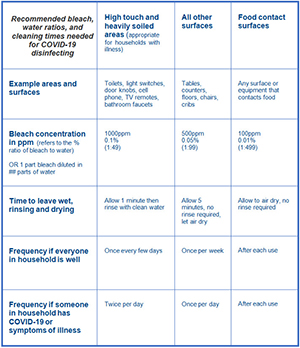Cleaning your home with household cleaning and disinfectant products can help prevent the spread of illness including COVID-19.
Regular cleaning and disinfecting can help prevent the spread of illness including COVID-19. Frequently touched surfaces such as toilets, sink tap handles, doorknobs, light switches, and tables should be cleaned at least daily. Other less frequently touched surfaces should be cleaned regularly when visibly dirty. Make sure to clean surfaces with soap or detergent before disinfecting. The virus that causes COVID-19 can be broken down by soaps and detergents as well as appropriate disinfectants. Cleaning and disinfecting is a simple, effective, two-step process that is described below.
Use soapy water to wipe away dirt, soils and other debris. Plain dish soap or any kind of household cleaning product will remove dirt, oils and other debris from surfaces.
If possible, use store-bought disinfectants. Familiar brands such as Clorox, Lysol, Fantastik, Microban and Zep have specific products that will work against the COVID-19 virus. Please check Health Canada’s list of approved products. If your product is not on the list, it has not been approved for this use.
If store-bought disinfectants are not available, you can mix household bleach with room temperature water (do not use hot water) in specific ratios to disinfect areas in your home. Household bleach should be diluted. It comes in different concentrations so check your label first before you mix (see information in table below).
Rinsing and drying recommendations are important parts of the disinfection process. For high-touch or heavily soiled areas such as toilets and sinks, leave 1000 ppm bleach solutions wet for one minute before wiping down the surface with a cloth soaked in clean water. Other bleach solutions of 500 ppm should be left wet for five minutes then air drying is fine. The table below provides more details.
The directions below use bleach that is 5.25%. For other concentrations please use the
FOODSAFE bleach calculator.
Bleach solutions may be used in spray bottles or wiped onto surfaces and other items. Bleach and water mixtures are effective for 24 hours so only make as much as you need daily.
Table 1. Recommended bleach, water ratios, and cleaning times needed for COVID-19 disinfecting.

Click table to enlarge
- Open a window and wear gloves when disinfecting.
- Take care to rinse the equipment that you use to make your bleach solution and keep bleach tightly-sealed and stored away from children and pets.
- More concentrated solutions are not better and may cause irritation to the eyes and throat. Use the table above to make the right solution for your needs.
- Do not mix bleach with vinegar or other acids like lemon juice, ammonia-containing products (such as Windex), or rubbing alcohol. This can create toxic gases.
- When using bleach on surfaces, allow the surface to air dry completely before using again.
- Dispose of any leftover bleach mixtures so people won't mistake them for something else or mix them with other products by mistake. If you pour your extra bleach solutions down the drain, run a lot of water down the drain at the same time.
- Never use bleach or other disinfectants on food. Rinse fresh vegetables and fruits with clean potable water.
- Utensils, pots and pans, and other dishwasher-safe food preparation items can be cleaned and sanitized in the dishwasher with a hot rinse cycle or washed with hot soapy water.
- Clean toys in hot soapy water with a brush for hard-to-reach areas prior to disinfecting; rinse thoroughly.
- To disinfect toys:
- Use a store-bought disinfectant that is safe for children; or&
- Use 5.25% household bleach to make a weaker disinfectant by mixing 1 part of bleach to 499 parts water or 2mL (3/8 teaspoon) bleach to 998mL
- Dishwasher-safe, hard plastic toys can be cleaned and disinfected in a dishwasher with a hot rinse cycle
Mobile phones and other frequently touched electronics like tablets, remotes, keyboards, mice and gaming consoles can carry germs. These electronics should be cleaned and disinfected regularly.
- First, remove visible dirt, grease, etc.
- Check the manufacturer's instructions for cleaning and disinfecting.
- If no manufacturer guidance is available, use disinfectant wipes or sprays with at least 70% alcohol.
- Dry surfaces thoroughly to avoid pooling of liquids.
- Do not immerse devices in liquids and do not use hydrogen peroxide or vinegar as they do not work and may damage screens.
- Consider using plastic covers or screen protectors to make cleaning and disinfection easier.
If you are living with someone who is ill, take these precautions when doing laundry:
- Laundry should be placed in a laundry basket with a plastic liner.
- Don’t shake dirty items
- Wear gloves and a mask when handling.
- Wash with regular laundry soap and hot water (60-90°C)
- Clean your hands with soap and water immediately after removing your gloves.
If you are sick or living with someone who is sick, be careful when touching waste.
- All waste can go into regular garbage bins.
- Line the wastebasket with a plastic bag. This makes waste easier and safer to dispose.
- When emptying wastebaskets, take care to not touch used tissues with your hands.
- Clean your hands with soap and water after emptying the wastebasket.
For information about hand sanitizers and hand washing, see the
hand washing page.
If you or someone you know has been exposed to a disinfectant or sanitizer, do the following first aid measures and call your local
Poison Control Centre: 1.800-567-8911.
- Inhalation: ventilate the area and seek fresh air
- Eye exposure: flush eyes with water for 5-10 minutes
- Skin exposure: flush skin with water for 5 minutes
- Ingestion: drink ½ cup to 1 cup of water.

